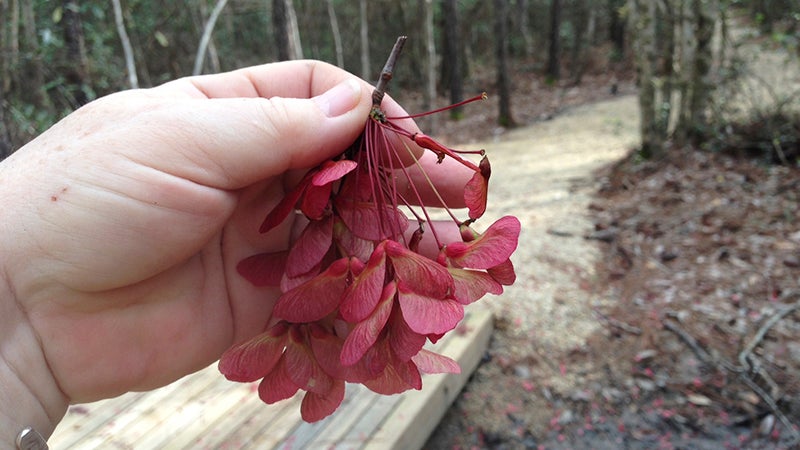Mississippi’s native and invasive plant species
Published 7:00 am Wednesday, July 24, 2019

- In springtime, you may find the red winged seeds of red maple, called samaras, scattered on the ground. Submitted photo.
By Patricia R. Drackett
As a child, did you know the names of the trees, shrubs, and herbaceous plants you played among? Perhaps you knew their stories, for example, how toothbrushes were once fashioned from twigs cut from sweetgum trees.
Have you learned to tell the difference between the native plant species growing in your yard, as well as possibly invasive plants? This may be something you have never thought about. But if you purchase a new piece of land, or go outside for a stroll of your property, you may find yourself wondering – what do I keep? What should I remove?
The majority of us could probably pick out an oak, a maple or sweetgum. Definitely a pine tree or Southern magnolia. Although it is easy to get overwhelmed, students visiting the Arboretum on a leaf collecting trip have most likely learned a basic truth – if you will learn a few dozen trees, you’ll be able to identify over three-fourths of the trees along our pathways. The same is true for shrubs, but less so with herbaceous species since there are so many. However, plants with showy blooms command attention, so you can start there.
Why should you consider learning about, and using, more native plants in your home landscape? The simple answer is that if you choose plants that prefer to grow in your property’s specific environmental conditions – species adapted to your local climate – you will spend less money and labor tending your landscape. Native plants are the ultimate choice for low-maintenance yards!
Learn to identify and remove the invasive non-native plant species that displace native species. Download the PDF list of “Mississippi’s 10 Worst Invasive Weeds” on the MSU Extension website (http://extension/msstate.edu). Extension publication No. M1194 includes methods for controlling exotic species such as cogon grass, Chinese privet, and Chinese tallow tree. On this same site, search for the “Smart Landscapes” page to discover many labor-saving, sustainable plants and landscape design and management practices.
Native plants have developed close relationships with, and provide support for, local wildlife. For example, insects have specific associations with particular species. Because of this, native plants attract a greater variety of insects to feed on them than ornamental species. Reductions in the variety of native plant species can in turn reduce the insects, and the wildlife species in an area.
You don’t need to replace of all of your ornamental plants with natives. Simply understanding the usefulness and function of native species is a starting point to creating ecologically sound landscapes, no matter the size of your yard. Native plants can function as the low-care backdrop for the plants you will continue purchase on impulse at the garden center.
Another helpful site is www.southeasternflora.com. This is a great tool specifically designed for those with limited knowledge of plants. Here, you can easily identify native or naturalized species by entering a few characteristics and choosing from a list of possibilities. If you have a smart phone, you can even access this site on a field walk.
The Crosby Arboretum’s Plant Data Base is linked from our website’s home page at www.crosbyarboretum.msstate.edu. View photos and learn more about the plants that you encounter in our exhibits. If you prefer a hard copy, select the printer-friendly list and carry this with you on your next visit. Make notes about what you find on your trip.
A kids’ workshop on “Tiny Gardening” will be held Friday, July 26, 11:00 a.m. to Noon.
Children will learn about small space gardening through fun hands-on activities in this workshop led by Dr. Christine Coker, Associate Research and Extension Professor of Urban Horticulture. Members’ children $2; non-member children $4. Children must be accompanied by parent or guardian; no charge for adults
On Saturday, July 27, 10:00 to 11:00 a.m. attend a program on “Native and Invasive Plants of Louisiana and Mississippi”. David Baker, Environmental Curator of A Studio in the Woods/Tulane ByWater Institute. Learn about our region’s native and invasive species and the impact that events such as hurricanes have on their movement and growth as well as the plight the gulf south is now facing with Chinese Tallow, Chinese Privet, and the lack of fire management. Members $3, non-members $5. Reservations requested for all programs, please call 601-799-2311 to sign up now for programs. While you are visiting the Arboretum, check out the beautiful pencil drawings by talented local artist Robin Veerkamp, which will be on display in the Arboretum gallery through the end of August.
For more information on programs, please see the Crosby Arboretum website. Our public garden is located at 370 Ridge Road in Picayune, at I-59 Exit 4, and is open Wednesday through Sunday from 9:00 to 4:30. Leashed pets are welcome.



